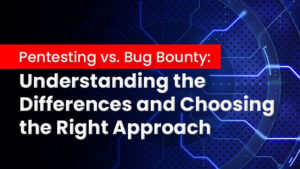Introduction
Software solutions and technologies for application security are made to find and reduce threats and vulnerabilities in software applications. Their primary objective is to shield applications from harmful assaults, unauthorized access, and data breaches.
These tools are essential for maintaining sensitive data’s security, integrity, and confidentiality, including financial records and personal information. Organizations can lower the risk of exploitation and mitigate the impact of security incidents by proactively detecting and repairing potential security issues. This article covers detailed knowledge of Application Security Tools & Software.
Check Out Our Cybersecurity Courses Now!
The Growing Importance of Application Security
As the digital landscape evolves, so do the threats that target applications. Cybercriminals continually devise new strategies to exploit vulnerabilities, compromising data, privacy, and business operations. This makes application security a paramount concern for individuals, businesses, and organizations.
- Data Protection: Applications often handle sensitive information, including personal details, financial data, and intellectual property. A breach can lead to data theft or manipulation, resulting in significant financial and reputational damage.
- Regulatory Compliance: Stringent data protection laws like GDPR and HIPAA require organizations to secure personal and healthcare data. Failure to comply can lead to severe fines.
- Reputation: Security breaches can erode trust among users and customers, making maintaining a strong security posture imperative.
- Business Continuity: Cyberattacks can disrupt critical services, leading to downtime and lost revenue.
Application Security Tools and Software
Below are the Application Security Tools and Software:
-
GitGuardian Internal Monitoring
Best dedicated secrets scanning
GitGuardian, founded in 2017, specializes in protecting sensitive data and trade secrets kept in source code repositories. It is an expert in identifying and avoiding the disclosure of API keys, credentials, certificates, and other private information. It provides real-time scanning, connections to well-known version control platforms like GitHub and GitLab, and alarms for possible security lapses involving sensitive data in code.
Key Features
- Surveillance of both public and private repositories in real-time
- Secrets in internal Git repositories are detected
- Alerts for detection and correction
- Application for incident response developed by developers
Pros
- Simple setup with a 30-minute quick-start tutorial
- Streamlined communication and incident resolution
- Reduces cleanup efforts by concentrating on essential issues
- Automatic notification of incidents for quicker action
- Integration with GitHub to identify code secrets and prevent merges
Cons
- Simple installation and a 30-minute quick-start guide
- By focusing on the most critical concerns, streamlined communication, and incident response reduce cleanup work
- Automatic incident notification for faster response
- A free alternative is integration with GitHub to spot code secrets and stop merges
Best for Programming Language Support
Static, dynamic, and software composition analysis are all provided by Veracode, a thorough application security solution. It provides many security testing features, such as code scanning and vulnerability evaluation. Veracode offers comprehensive reports on security flaws and application shortcomings and supports over a hundred programming languages.
Key Features
- Software Composition Analysis for Dynamic Application Security Testing
- Testing for interactive application security
- eLearning and Security Development Training
- Management of the Application Security Program
Pros
- Accurate scanning for vulnerabilities
- Demonstrates the degree of danger and the seriousness of the vulnerabilities
- The vast collection of remedial advice
- Outstanding client service
- both APIs and integrations
Cons
- The user interface can be challenging to utilize. Users have also complained about poor performance and erroneous positives.
Best DevOps Unified Platform
GitLab has built-in application security measures and is mainly known as a version control system and DevOps platform. GitLab enables continuous security monitoring and mitigation by integrating security testing into the development workflow.
Key Features
- Testing for Static Application Security
- Testing for Dynamic Application Security
- Coverage-guided Dependency Scanning License Scanning security testing for APIs
Pros
- Streamlined integration of the Git CLI
- Calls for a seamless merge
Cons
- The documentation might be more comprehensive and user-friendly
- Better integration with third-party software is possible
- It may be challenging to switch between branches in a repository
- File editing in a browser can be complex
- CI/CD-related error messages may contain additional information
Best for Vulnerability Management
Qualys is a cloud-based security platform that provides comprehensive security and compliance solutions, including application security. It also includes tools for online application scanning and vulnerability management. It provides online application scanning and assessment to find vulnerabilities and potential security problems, as well as detailed reporting and repair. Qualys’ security coverage is as extensive as possible and may be more than certain enterprises require.
Key Features
- Vulnerability administration
- PCI compliance Security assessment questionnaire Policy compliance
- Scanning of web applications
- API for asset management, container, and cloud data collection
Pros
- Automated web application scanning
Cons
- Options for 2FA could be expanded
- It may be simpler to add domains and networks
- The discovery and scanning setup might be improved
- Module integration might be improved
Essential Features of Application Security Software
- Application security tools include several critical capabilities that add to an application’s overall security posture by defending against unauthorized access, data breaches, and other security concerns.
- Authentication ensures that users or entities are authenticated and have appropriate access granted depending on their identity. It entails checking credentials such as usernames and passwords before providing application access. The more difficult it is to steal, the better.
- Authorization determines which activities and resources a person or entity is permitted to execute or access within an application. This enforces access control regulations and limits privileges based on roles or permissions to prevent unwanted access.
- Encryption protects sensitive data by converting it to a coded format that can only be seen or decrypted with the appropriate key. Encryption keeps data private and secures it even if intercepted or viewed by unauthorized people.
- Logging logs are records of events and actions within an application or resource that aid in monitoring and auditing to identify regular and unusual user behavior patterns.
- Application security testing assesses and evaluates applications to find vulnerabilities, weaknesses, and security problems.
Challenges in Application Security
While application security tools are crucial, they are not a one-size-fits-all solution. Challenges in application security include:
- Complexity: As applications become more intricate, security measures need to adapt to encompass all potential attack vectors.
- Zero-Day Vulnerabilities: Attackers often exploit vulnerabilities that are not yet known, making it difficult to defend against new threats.
- Resource Constraints: Smaller organizations may struggle to invest in comprehensive security solutions, leaving them more vulnerable.
- Human Error: Even the best tools are only as effective as the individuals operating them. Training and awareness are vital.
Conclusion
Before purchasing an application security product, it is critical to prioritize your organization’s particular requirements and do a comprehensive search. Prospective purchasers should consider features and capabilities, supported programming languages, compatibility with current infrastructure, scalability, ease of usage, cost, and the degree and quality of technical support given. Including critical stakeholders in the decision-making process, such as IT security teams and developers, is also critical.







